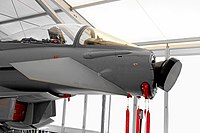
Photo from wikipedia
In this paper, an efficient digital predistortion (DPD) architecture utilizing over-the-air (OTA) feedback is presented to linearize phased array transmitters. It places one additional observation antenna (OA) in the far… Click to show full abstract
In this paper, an efficient digital predistortion (DPD) architecture utilizing over-the-air (OTA) feedback is presented to linearize phased array transmitters. It places one additional observation antenna (OA) in the far field to capture the combined signal of the array outputs and uses the combined signal to build a nonlinear model that describes the joint nonlinear distortions of all the power amplifiers (PAs) in the phased array. Then, a corresponding DPD model is extracted by the typical indirect learning method to linearize the phased array. After introducing this DPD architecture, the relationship between the OA position and the performance of the extracted DPD model is specifically explored, and two significant results are found. First, when the OA is perfectly colocated in the main beam direction, the DPD coefficients extracted with an arbitrary steering angle for the phased array are also applicable to any other steering angle. Second, when the OA is not perfectly placed in the main beam direction, the linearization performance for the extracted DPD coefficients will degrade as the OA placement mismatch increases, and the phased array has an optimum steering angle at which the OA placement mismatch has a minimal influence on the DPD performance. Based on the above two results, a new DPD training strategy is proposed, which extracts only one set of DPD coefficients by making the phased array point at the optimum steering angle. The advantages of the proposed strategy are that the OA can be placed in a relatively wide range of positions and that the extracted coefficients will be applicable to any other steering angle. The two results and the proposed DPD training strategy are verified by simulations, which are conducted on a $1\times 4$ uniform linear array (ULA) and a $4\times 4$ uniform rectangular array (URA).
Journal Title: IEEE Access
Year Published: 2021
Link to full text (if available)
Share on Social Media: Sign Up to like & get
recommendations!